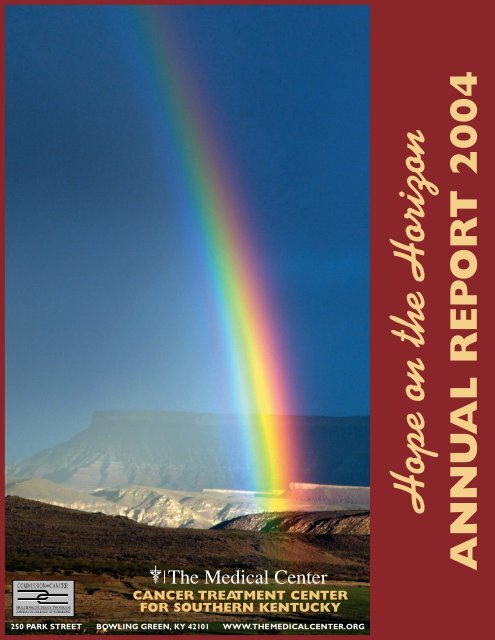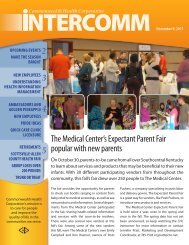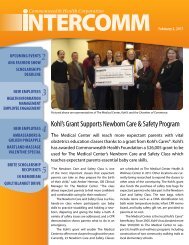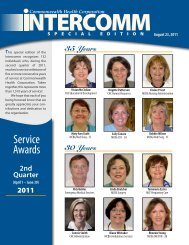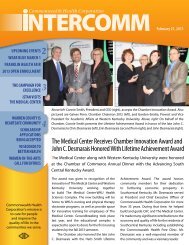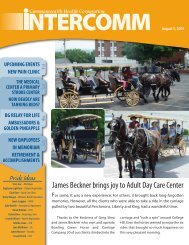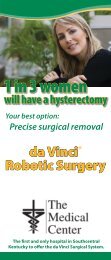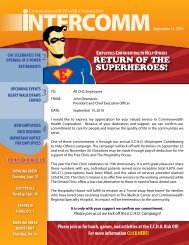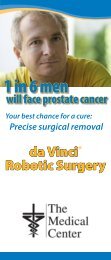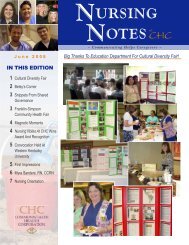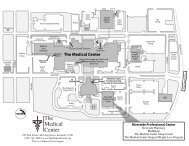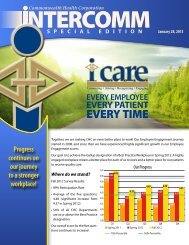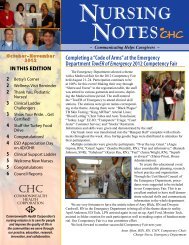Cancer Annual Report 2004 - The Medical Center
Cancer Annual Report 2004 - The Medical Center
Cancer Annual Report 2004 - The Medical Center
You also want an ePaper? Increase the reach of your titles
YUMPU automatically turns print PDFs into web optimized ePapers that Google loves.
<strong>The</strong> <strong>Medical</strong> <strong>Center</strong><br />
CANCER TREATMENT CENTER<br />
FOR SOUTHERN KENTUCKY<br />
250 PARK STREET BOWLING GREEN, KY 42101 WWW.THEMEDICALCENTER.ORG<br />
Hope on the Horizon<br />
ANNUAL REPORT <strong>2004</strong>
Message from the chairperson<br />
I present this report to you with a thankful heart for the diligent<br />
efforts of our <strong>Cancer</strong> Committee, our <strong>Cancer</strong> Care Staff and our<br />
Tumor Registry Staff.<br />
We were gratified by our recognition as an accredited cancer program<br />
by the American College of Surgeons. This year we worked to<br />
expand the services to our patients and the community.<br />
Technological advances in cancer care are critical for achieving the<br />
highest rates of symptom control and cure. <strong>The</strong> new radiation therapy<br />
equipment is a step in that direction. <strong>The</strong> personal side of cancer<br />
care is no less important. <strong>The</strong> Palliative Care initiative and ongoing oncology staff training in<br />
pain control are directions toward maximizing quality of life.<br />
We are proud to be a part of the community effort towards early diagnosis, prevention, and<br />
research with the goal to decrease the impact this disease has on families. I am grateful for<br />
the opportunity to have been part of this team.<br />
We all appreciate the trust patients and their families have given to <strong>The</strong> <strong>Medical</strong> <strong>Center</strong><br />
<strong>Cancer</strong> Care Team and we will strive to continue to earn that trust.<br />
Jane R. Bramham, M.D.<br />
Committee Chairperson<br />
<strong>Cancer</strong> Committee Members<br />
Jane Bramham, M.D.<br />
<strong>Medical</strong> Oncology<br />
Committee Chairperson<br />
Jake Barrick<br />
<strong>Medical</strong> Staff Coordinator<br />
Irene Bates<br />
Director – Marketing Communications<br />
James Beattie, M.D.<br />
Pathology<br />
David Bergamini, M.D.<br />
Urology<br />
Georgena Brackett<br />
Director<br />
Health Information Management<br />
Raymond P. Cloutier, M.D.<br />
Internal Medicine<br />
Chris Desmarais<br />
Senior Vice President<br />
M. James Gaffney, M.D.<br />
Family Practice and Palliative Medicine<br />
Kendra Garvin<br />
Tumor Registry<br />
Daniel Geis, M.D.<br />
Pathology<br />
Tumor Conference Coordinator<br />
Gerri Glenn<br />
Director - Social Services<br />
Tage Haase, M.D.<br />
General Surgery<br />
Physician Liaison<br />
Bridget Kilpatrick<br />
Clinical Manager – Oncology<br />
Sarah Moore<br />
Vice President<br />
Linda Rush<br />
Director - Community Wellness<br />
Richard McGahan, M.D.<br />
Radiation Oncology<br />
Paul Ramsingh, M.D.<br />
Chief of Radiology<br />
Eddie Scott<br />
Director<br />
Departments of Radiation Oncology<br />
and Radiology<br />
Jana Thornton<br />
Tumor Registry<br />
Sandra Webb<br />
<strong>Medical</strong> Staff Coordinator<br />
Laura Williams<br />
Supervisor<br />
Health Information Management<br />
Michael Zachek, M.D.<br />
Pulmonary and Critical Care Medicine
Case Counts By Year<br />
BOWLING GREEN COMBINED<br />
<strong>Report</strong>ing Accession Years: 1999 to <strong>2004</strong> — Case Classes Included: 0, 1, 2<br />
Site 1999 2000 2001 2002 2003 <strong>2004</strong><br />
Lip 2 0 1 0 0 0<br />
Tongue 2 6 2 5 3 5<br />
Salivary glands 1 0 1 2 3 5<br />
Gum & hard palate 0 0 2 1 0 0<br />
Floor of mouth 0 0 3 0 1 3<br />
Buccal mucosa 1 1 1 0 0 0<br />
Oropharynx 0 2 1 7 7 4<br />
Nasopharynx 1 0 2 0 3 3<br />
Hypopharynx 1 0 0 3 0 1<br />
Other oral cavity 0 1 0 0 0 0<br />
Esophagus 4 4 13 7 6 10<br />
Stomach 7 4 6 6 5 3<br />
Small Intestine 2 0 3 1 1 4<br />
Colon 51 65 51 46 51 48<br />
Rectum/Anus 15 19 33 22 36 23<br />
Liver 3 3 5 2 4 1<br />
Gallbladder 1 5 4 4 5 0<br />
Pancreas 9 12 7 10 12 11<br />
Other digestive tract 1 1 0 2 0 0<br />
Nasal cavities,sinuses,ear 0 2 0 0 1 1<br />
Larynx 15 8 12 21 20 20<br />
Trachea,bronchus,lung-small 32 32 41 39 42 41<br />
Trachea,bronchus,lung-NSC 86 109 133 152 158 151<br />
Other respiratory 0 1 0 1 3 3<br />
Bone 0 0 0 2 1 0<br />
Connective & soft tissue 5 6 2 0 3 6<br />
Malignant melanoma 18 23 21 24 17 16<br />
Other skin 2 5 9 3 1 1<br />
Breast, female & male 105 118 121 161 124 149<br />
Cervix 4 11 6 14 7 8<br />
Endometrium (corpus uteri) 10 24 7 12 11 16<br />
Ovary 4 5 3 7 6 8<br />
Other female genital organs 1 6 5 4 2 9<br />
Prostate 33 48 56 84 73 74<br />
Testis 5 3 6 1 4 10<br />
Other male genital organs 0 1 3 3 0 2<br />
Bladder 12 23 17 27 36 24<br />
Kidney 15 6 14 16 14 13<br />
Other urinary organs 2 1 2 2 1 1<br />
Brain 6 7 8 10 15 12<br />
Thyroid 28 25 24 18 14 16<br />
Other endocrine 0 1 0 0 0 0<br />
Hodgkin’s 2 11 6 4 4 3<br />
Non-Hodgkin’s Lymphomas 19 24 22 26 22 19<br />
Plasma cell tumors 6 8 4 7 4 5<br />
Lymphocytic leukemias 9 7 5 8 3 2<br />
Myeloid leukemias 3 9 5 2 6 2<br />
Other leukemias 0 1 2 2 2 0<br />
Myeloprolif. & myelodysplas. 0 0 0 2 0 1<br />
Unknown primary 15 30 23 22 21 16<br />
Benign/borderline brain,cns 0 0 0 0 0 9<br />
Total 538 678 692 792 752 759<br />
Top Five <strong>Cancer</strong> Sites – <strong>2004</strong><br />
(Comparing <strong>The</strong> <strong>Medical</strong> <strong>Center</strong> top five sites with Kentucky and National data)<br />
Site <strong>The</strong> <strong>Medical</strong> <strong>Center</strong> Kentucky National<br />
Lung 26% 19% 13%<br />
Breast 19.40% 17% 16%<br />
Prostate 10% 9% 17%<br />
Colon 6% 10% 8%<br />
Bladder 3% 4% 5%
Skin <strong>Cancer</strong><br />
“Fry now…pay later” could refer to the personal cost of sunburns<br />
and deliberate sun exposure/tanning. Harmful ultraviolet<br />
rays from the sun cause most skin cancers. This damage is generally<br />
accumulated over many years. Blistering sunburns in<br />
childhood may be the initial step toward skin cancer in later<br />
years but every unprotected sun exposure over a lifetime adds to<br />
the risk of eventually developing a skin cancer. Other less frequent<br />
causative factors for skin cancer include repeated x-ray<br />
exposure, scarring from certain skin conditions or burns, certain<br />
occupational hazards (coal, arsenic) and family history. People<br />
at greatest risk for skin cancers are those with fair skin, light<br />
hair and eyes who sunburn easily. However, even someone with<br />
much darker skin and little tendency for sunburn may develop<br />
skin cancer with repeated significant prolonged sun exposure.<br />
<strong>The</strong>re are three types of skin cancer: basal cell carcinoma,<br />
squamous cell carcinoma and malignant melanoma. Basal cell<br />
skin cancers usually appear as small shiny, translucent or pigmented<br />
bumps that slowly increase in size and may become a<br />
bloody, non-healing “sore.” This type of cancer is the most common<br />
skin cancer and rarely spreads internally but may cause significant<br />
local destruction. Squamous cell cancer, the second<br />
most common skin cancer, may appear as red, scaly patches or<br />
large bumps and is capable of spreading internally. Malignant<br />
melanoma may develop within a pre-existing mole or may<br />
develop on normal appearing skin. A melanoma is usually<br />
darkly colored but in rare instances may be skin-toned, reddish<br />
or even white. Melanoma has a strong tendency to spread and<br />
may be fatal if allowed to spread.<br />
Like any other cancer, early detection of skin cancer is<br />
essential for best outcome. Examine your skin monthly for new<br />
or changing skin lesions. Look for new, persistent unusual<br />
bumps, new persistent scaly patches on any skin surface but<br />
especially on the sun-exposed skin. With moles, look for change<br />
in size, shape, color, spread of color from the mole into surrounding<br />
skin and new sensation in a mole such as itching,<br />
tenderness or pain.<br />
You can decrease your risk for skin cancer. Avoid deliberate,<br />
prolonged unprotected sun exposure, especially between<br />
10 a.m. and 4 p.m. Apply a sunscreen with SPF at least 15 with<br />
UVA/UVB coverage every day. Wear a hat with a brim and<br />
other protective clothing when possible. Be aware if any of your<br />
prescribed oral medications cause increased sensitivity to sunlight.<br />
Avoid tanning in the sun or in tanning beds. Examine your<br />
skin on a regular basis. See a dermatologist annually for a full<br />
skin exam.<br />
Jo Ann D. Jones, M.D.<br />
Dermatology/Graves-Gilbert Clinic<br />
Story of a Survivor: Shawn Rhodes<br />
On February 16, 1999 Shawn Rhodes was at Graves Gilbert<br />
Clinic for an appointment with Dr. Stephen Slaughterbeck<br />
regarding a few spots on his face that he believed were suspicious<br />
and cause for concern. <strong>The</strong> spots Shawn was worried<br />
about were not dangerous, but some other spots were of great<br />
concern to Dr. Slaughterbeck. Shawn’s examination was more<br />
intense than he expected and at 9:38 a.m. he was diagnosed with<br />
a very aggressive type of melanoma skin cancer. Shawn was<br />
scheduled for surgery on Thursday, two days later. He was to<br />
have lesions removed on his lower back, right buttock, and<br />
right calf.<br />
Shawn’s surgery on Thursday, February 18, 1999 was just<br />
the first of many. His series of surgeries totaled 30, some<br />
smaller and less intense than others. <strong>The</strong>se surgeries allowed<br />
Shawn to avoid radiation and chemotherapy; for that he felt very<br />
fortunate. <strong>The</strong> largest spot of cancer was located on his lower<br />
calf. To regain strength in his leg, he attended rehabilitation. He<br />
was forced to walk with crutches for one month, but soon<br />
moved to one crutch and then a single cane for several weeks.<br />
Shawn experienced a slight depression with the scare of<br />
facing cancer. Melanoma runs in his family and had been the<br />
cause of his aunt’s death when he was 12. His grandfather’s<br />
death was also cancer related. Thinking about the losses due to<br />
cancer, Shawn was overcome with fear because of his young<br />
age and the life he had always been looking forward to.<br />
With his family’s support and on-going spiritual life, Shawn<br />
came out of his depression and began looking into all of the<br />
positive aspects of his life.<br />
He became more involved<br />
in his church and community<br />
and continued to<br />
change his life in a positive<br />
way. Becoming more<br />
physically active and improving<br />
his health has<br />
brought Shawn to where<br />
he is today. He is currently<br />
involved in triathlon and<br />
marathon training and will<br />
soon be involved in a 150-<br />
mile bike ride.<br />
Looking back on his<br />
cancer experience, Shawn<br />
sees how much more he<br />
appreciates life. Lance<br />
Armstrong’s writings have<br />
contributed to his inspiration<br />
of making himself an<br />
all around better person<br />
and helps him know he can conquer anything. Shawn lives by the<br />
belief that knowledge is power and attitude is everything. Now<br />
at 32 years of age, Shawn is cancer free and schedules checkups<br />
every six months. He is the father of two young children.<br />
Shawn is living life to its fullest and enjoying every minute of it.
<strong>2004</strong> <strong>Cancer</strong> Registry <strong>Report</strong><br />
A cancer registry is an information system designed for the<br />
collection, management, and analysis of data on persons with<br />
the diagnosis of a malignant or neoplastic disease (cancer).<br />
<strong>Cancer</strong> registries maintain a wide range of demographic and<br />
medical information including diagnostic findings, cancer therapy,<br />
and follow-up. Since the initiation of the cancer registry at<br />
<strong>The</strong> <strong>Medical</strong> <strong>Center</strong> more than 9900 cases have been abstracted<br />
into the Kentucky <strong>Cancer</strong> Patient Data Management System<br />
(CPDMS). CPDMS is a computer-based system for collecting,<br />
managing and analyzing information related to the diagnosis,<br />
and treatment of cancer patients in Kentucky. <strong>The</strong> CPDMS system<br />
meets all of the requirements for an American College of<br />
Surgeons approved cancer program. <strong>The</strong> registry is maintained<br />
by two full time Certified Tumor Registrars who are responsible<br />
for casefinding, abstracting, and lifetime follow-up on all cancer<br />
patients diagnosed and/or treated at <strong>The</strong> <strong>Medical</strong> <strong>Center</strong>.<br />
Tumor conferences are held weekly and are attended by<br />
medical staff and other ancillary personnel. Radiological and<br />
pathological reports are reviewed and an open discussion is held<br />
among the physicians regarding management and staging for<br />
each individual case presented.<br />
<strong>The</strong> cancer committee meets quarterly and includes participation<br />
from a multi-disciplinary team to assure quality care to<br />
all cancer patients. <strong>The</strong> information included in this report summarizes<br />
data for the year <strong>2004</strong>. For more information regarding<br />
the <strong>Cancer</strong> Registry or related data, call 270–745–1288 or<br />
270–796–5104.<br />
Jana Thornton, RHIT, CTR<br />
Kendra Garvin, RHIT, CTR<br />
American <strong>Cancer</strong> Society <strong>Report</strong><br />
Since 1913, the American <strong>Cancer</strong> Society, through the tireless<br />
efforts of supporters like <strong>The</strong> <strong>Medical</strong> <strong>Center</strong>, has offered<br />
hope, progress, and answers to millions of cancer patients and<br />
their families. <strong>The</strong> five-year relative survival rate of cancer<br />
patients has gone from 25 percent in 1946 to approximately 64<br />
percent for all cancers diagnosed between 1995 and 2000. But<br />
the American <strong>Cancer</strong> Society won’t rest until the fight to end<br />
cancer is over.<br />
<strong>The</strong> <strong>Medical</strong> <strong>Center</strong> and American <strong>Cancer</strong> Society serve as<br />
partners on many levels, including;<br />
Patient services:<br />
• <strong>The</strong> <strong>Medical</strong> <strong>Center</strong> is a recipient of a transportation grant<br />
that assists patients receiving treatment at their cancer<br />
centers in Bowling Green and Glasgow.<br />
• Staff refers patients to the American <strong>Cancer</strong> Society programs<br />
such as I Can Cope education sessions; Look Good<br />
…Feel Better, Man to Man, Reach to Recovery, and Road<br />
to Recovery.<br />
• Sessions (such as Look Good…Feel Better and I Can<br />
Cope) are held at <strong>The</strong> <strong>Medical</strong> <strong>Center</strong> and their Health<br />
& Wellness <strong>Center</strong> located in the Greenwood Mall.<br />
• <strong>The</strong> <strong>Medical</strong> <strong>Center</strong> staff also refers patients to the<br />
American <strong>Cancer</strong> Society’s Information <strong>Center</strong>,<br />
1–800–ACS–2345 and to the local office for information,<br />
financial assistance and personal items (i.e. wigs,<br />
mastectomy bras and breast forms.)<br />
Volunteerism:<br />
• Employees from <strong>The</strong> <strong>Medical</strong> <strong>Center</strong> are involved in<br />
advocacy efforts on the local and state level.<br />
• Employees from <strong>The</strong> <strong>Medical</strong> <strong>Center</strong> form teams and<br />
raise money for Relay For Life and serve on the statewide<br />
Relay Leadership Committee.<br />
• Employees serve as speakers for American <strong>Cancer</strong><br />
Society education and patient support programs.<br />
• Employees serve as local leadership volunteers<br />
<strong>2004</strong> Melanoma Cases<br />
100 -<br />
90 -<br />
80 -<br />
70 -<br />
60 -<br />
50 -<br />
Survival %<br />
40 -<br />
30 -<br />
20 -<br />
10 -<br />
0 -<br />
0 8 16 24 32 40 48 56<br />
Months Past Diagnosis<br />
Types of <strong>The</strong>rapy <strong>2004</strong><br />
Surgery (72%)<br />
Surg/Rad (21%)<br />
Surg/Chemo/Rad (7%)
<strong>2004</strong> <strong>Cancer</strong> Prevention, Education<br />
& Screening Series<br />
Programs that are available monthly throughout the year<br />
include Mammography Days, <strong>Cancer</strong> Patients & Family Support<br />
Group meetings and Man to Man Prostate & Testicular Support<br />
Group meetings (ASC) and Cooper Clayton Smoking Cessation<br />
classes.<br />
January<br />
• Health & Wellness Expo (cancer prevention educational materials,<br />
colon cancer screening kits, breast & testicular detection,<br />
demonstrations, oral cancer screenings)<br />
• Body Fat Screenings (Health & Wellness <strong>Center</strong>)<br />
• Nutrition/Exercise – Behavioral Lifestyle Changes for Health<br />
Class (Health & Wellness <strong>Center</strong>)<br />
• Weigh to Wellness (eight-week weight loss program)<br />
• American <strong>Cancer</strong> Society Services Class (information on<br />
nutrition, pain relief, money management, support groups and<br />
programs presented at the Health & Wellness <strong>Center</strong>)<br />
• Promotion of age specific screenings and diagnostic test for<br />
men to Men’s Health Alliance members<br />
• <strong>Cancer</strong> Prevention and Detection materials distributed at<br />
Dollar General Health Fair<br />
February<br />
• Fit for Life (program for children focusing on development of<br />
healthy eating habits and basic activity patterns)<br />
• Catholic Church Health Fair<br />
• <strong>Cancer</strong> Prevention and Detection materials distributed at Holy<br />
Spirit<br />
• Colorful Choices: 5 A Day Fruits & Vegetables Program promoted<br />
to the City of Bowling Green (benefit of increasing<br />
intake is cancer prevention)<br />
• Breast Self-Exam and Testicular Self-Exam Education for students<br />
at Warren Central High School<br />
March<br />
• Three-day food diary analyzed by dietitian (Health &<br />
Wellness <strong>Center</strong>)<br />
• Eat Smart, Stay Healthy Class (promotion of Five-A-Day)<br />
• Look Good Feel Better session (Health & Wellness <strong>Center</strong>)<br />
• MOPS (Mothers of Preschoolers) presentation on Women’s<br />
Health with a focus on Breast <strong>Cancer</strong> awareness<br />
• BRASS (Barren River Area Safe Space) Presentation on<br />
Colorful Choices: Five-A-Day Fruits & Vegetables Program<br />
(benefit of increasing intake is cancer prevention)<br />
• Breast <strong>Cancer</strong> Awareness program for women’s group at<br />
Broadway Methodist Church<br />
April<br />
• Fit for Life (8 week program promoting good nutrition &<br />
activity for children)<br />
• Rollout of <strong>The</strong> <strong>Medical</strong> <strong>Center</strong>’s Healthy Kids Club (focus on<br />
good nutrition, physical activity, adapting healthy lifestyle<br />
habits including not smoking)<br />
• Nutrition for the Person With <strong>Cancer</strong> Class (Health &<br />
Wellness <strong>Center</strong>)<br />
• Humor & Health Class<br />
• “Hazards of Smoking”/YMCA Scottsville Children’s event<br />
• Breast <strong>Cancer</strong> Awareness session Scottsville Senior <strong>Center</strong><br />
May<br />
• Senior Health & Fitness Day (cancer prevention & educational<br />
materials distributed)<br />
• Lung Health Screening (Health & Wellness <strong>Center</strong>)<br />
June<br />
• Why Positive Living Matters (Women-in-Charge Luncheon)<br />
• PSA screenings (Health & Wellness <strong>Center</strong>) – 230 men<br />
screened/22 elevated<br />
• Dermascan/Sun damage screening (KCP) – 136 screened<br />
• ACS Look Good…Feel Better Program (Health & Wellness<br />
<strong>Center</strong>)<br />
July<br />
• Can Five A Day Keep <strong>Cancer</strong> Away (Women-in-Charge<br />
Luncheon/Scottsville & class at Health & Wellness <strong>Center</strong>)<br />
• Men’s Health Update<br />
• Quebecor/Franklin Health Fair—booth on breast and testicular<br />
cancer awareness<br />
• Radio interview/Franklin WKFN on breast health<br />
• Healthy Kids Club promotion in mall food court—<br />
weight/BMI<br />
August<br />
• Steps to Breast Health/Marilyn Wheat (Women-In-Charge<br />
luncheon, Franklin)<br />
• Making the Right Decision: <strong>Cancer</strong> Prevention &<br />
Detection/Dr. Jane Bramham (Women in Charge Luncheon,<br />
Bowling Green)<br />
• Promotion of Healthy Kids Club/distribution of HKC water<br />
bottles at Briarwood Elementary, Bowling Green<br />
• Promotion Healthy Kids Club/Franklin – Garden Spot Run<br />
September<br />
• Oral <strong>Cancer</strong> Screening<br />
• Can Five A Day Keep <strong>Cancer</strong> Away (Health & Wellness<br />
<strong>Center</strong><br />
October<br />
• Women’s Conference (oral cancer screenings, educational<br />
material, speaker on breast health & cancer awareness, dermascan)<br />
• Breast <strong>Cancer</strong> Awareness (Health & Wellness <strong>Center</strong>)<br />
• Promotion/education of screening mammography (WellNews<br />
newsletter)<br />
• Lung Health Screening<br />
• <strong>The</strong> Anti-<strong>Cancer</strong> Lifestyle Class (Health & Wellness <strong>Center</strong>)<br />
• ACS Look Good…Feel Better Class (Health & Wellness<br />
<strong>Center</strong>)<br />
November<br />
• Community Health Fair (Scottsville)<br />
December<br />
• Twelve Days of Wellness (Health & Wellness <strong>Center</strong> – nutrition,<br />
tea, stress mgt, setting healthy goals, controlling holiday<br />
eating, exercise, etc)<br />
• Avoiding Excessive Weight During the Holidays/Health &<br />
Wellness <strong>Center</strong> class<br />
• ACS Look Good/Feel Better Class (Health & Wellness<br />
<strong>Center</strong>)<br />
• Wellness Diary’s for holiday gift to Women’s <strong>Center</strong> members<br />
with cancer prevention, early detection information.


